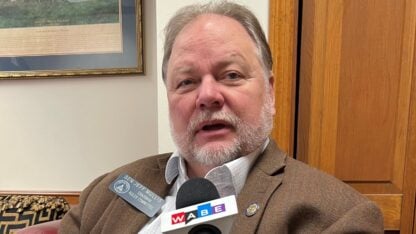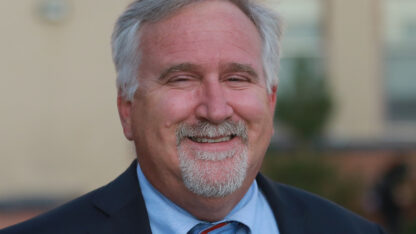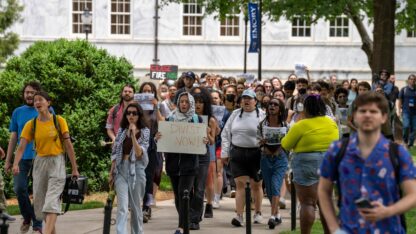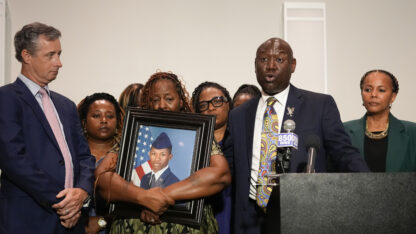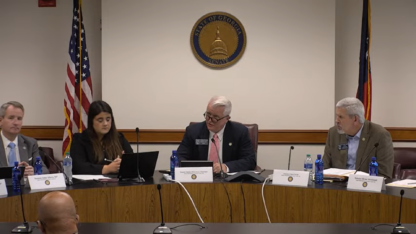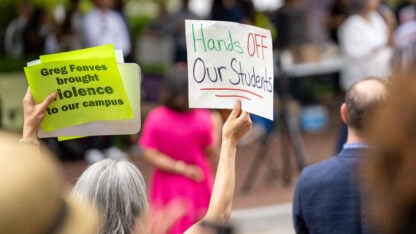Gwinnett Elementary School Immerses Students In Spanish Language

Elly Yu / WABE
This story is part of WABE and American Graduate’s Advancing Atlanta: Education series. For more stories, click here.
In teacher Yahaira Rosa-Serrano’s first-grade class at Bethesda Elementary School in Lawrenceville, about 20 students are going over Spanish words.
Repeat after me, Rosa-Serrano says. “La Alfombra,” the students reply. They’re sitting in a room where everything from the art on the walls to the classroom rules are in Spanish.
To some, the word “alfombra,” or “rug,” comes easier than others since they come from homes that already speak Spanish. But across the hall, another team of students is taking on English grammar.
Everything in the other partner classroom, led by Tracy Peska, is in English.
The program at Bethesda is called “dual language immersion,” and it started with last year’s kindergarten class. The students spend half their day learning in English and half of their day learning in a foreign language.
The Spanish part, however, goes way beyond learning just basic words or numbers. Students are taught entire subjects, like science and math, in the language.
Jon Valentine, director of foreign languages for Gwinnett County Public Schools, said the idea was first brought up more than a decade ago.
“Like a lot of school districts in the United States, we started to see our demographics shift,” Valentine said. “We wanted to ensure that we were offering programs that would be beneficial to all students to support success across the board and then, also provide our students an opportunity to be globally competitive.”
Bethesda Elementary School is majority-minority. About 60 percent of students there are Hispanic, 22 percent are black, 12 percent Asian, and 5 percent white, according to school administrators.
Valentine said a dual immersion program at the school was a good fit – where about half the students in the program are native Spanish speakers, and about half the students are native English speakers.
“Half the day, one set of students are the best kids in class. And the other half of the day, the other half of students are the best kids in class,” he said.
Valentine said district data show the program has been working so far. All students are performing as well as or better than their single-language peers, and although it’s too early to tell from the data, he said he hopes that English skills among Hispanic students will get better, quicker.
“The primary goal of this program is that everybody walks away from this school speaking English as well as every other student in every class. And that they’re content knowledge is on par, as well as, or better than any other student in any class,” he said.
It might seem counterintuitive to teach Spanish speakers part time in Spanish to improve their English, but research shows it works, said Tara Fortune, a professor and director of the Immersion Program at the Center for Advanced Research on Language Acquisition at the University of Minnesota. She said building literacy in a child’s native language is fundamental.
“Schooling through your first language for language-minority students will help position these kids for stronger English language skills and stronger academic performance,” she said.
Once vocabulary and concepts are understood in one language, it’s easier to transfer those skills to a second language, like English. And she said in some ways, written Spanish is an easier language to learn. 
For native English speakers in dual immersion, the benefit is fluency in another language starting at an early age. First-graders Stefano and Gianluca can do math in Spanish and demonstrate it in a song, and mastering fluency in another language is what got their mom, Lesli Seta, interested in the program.
“Kids this age are like sponges. And they’re curious, and they learn quickly and they want to learn.”
There might be more opportunities for students in the future, as the programs are growing. Five years ago, there were just three dual language programs in Georgia. Next year, officials say that number could be near 30.
This story is part of American Graduate, Let’s Make it Happen, a public media initiative made possible by the Corporation for Public Broadcasting.
9(MDAxODM0MDY4MDEyMTY4NDA3MzI3YjkzMw004))
